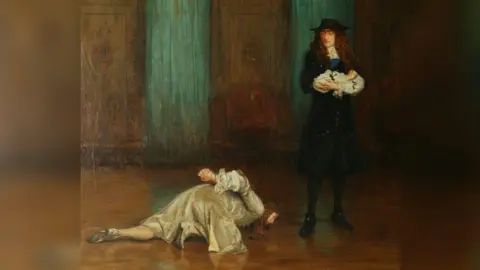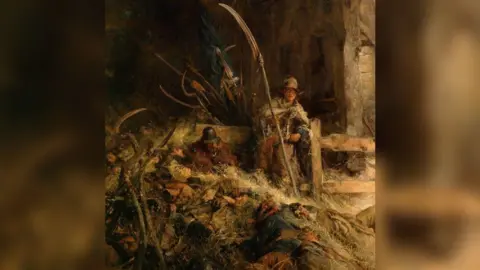Failed uprising remembered 340 years after battle
 Manchester City Galleries
Manchester City GalleriesA new exhibition telling the story of a 17th Century uprising aims to explore the tragic aftermath of the revolt and its affect on future generations.
The Monmouth Rebellion, which ended at the Battle of Sedgemoor in 1685, was a failed attempt to depose the Catholic King of England, James II.
Taunton Castle, which is hosting the event, was the scene of the Bloody Assizes where hundreds of mutineers were later condemned to be hung, drawn and quartered.
"The rebellion has a fundamental place in the story of Somerset, and the events that followed it have never been forgotten," said Sam Astill, chief executive of the South West Heritage Trust.
Tom Mayberry, co-curator of the exhibition, said it was "the cruelty which followed the rebellion which stayed so powerfully in people's minds" and was passed down through the generations.
"It's a warning to us of how societies can fracture and we see some of those consequences around us in the modern world, so I think the lessons of Sedgemoor have much relevance to our lives today.
"We are still the inheritors of the echoes of the sense of outrage and grievance, which people felt - that their protest had been so violently answered," he said.
 South West Heritage Trust
South West Heritage TrustAt the centre of the exhibition are two paintings on loan from the Tate and Manchester Art Gallery.
Edgar Bundy's The Morning of Sedgemoor (1905) shows frightened rebels sheltering in a barn after the battle, and John Pettie's The Duke of Monmouth's Interview with James II (c1882) shows the defeated leader vainly pleading for his life.
"The king was completely unmoved by his pleas for mercy and shortly thereafter he was beheaded at the Tower of London," said Mr Mayberry.
"It's important to remember those events, firstly from a purely historical point of view, because what happened then to West Country people was so terrible, but also it shows how quickly disagreements about religion and politics can descend into an utter fracture in society and how violently that fracture may find expression.
"We should also be aware of glamorous plausible leaders, who may be leading us to disaster," he added.
 Tate
TateOther items on display include an ostrich plume reputedly worn by the Duke of Monmouth on the battlefield, and 200 lead musket balls found recently at the site.
"I hope very much that it will draw anyone who has any sense that the Monmouth Rebellion might be something worth discovering," said Mr Mayberry.
 South West Heritage Trust
South West Heritage TrustThe exhibition, called After Sedgemoor: Remembering the Monmouth Rebellion, takes place from 29 March to 6 July at the Museum of Somerset.
"There couldn't be a better setting for the exhibition than Taunton Castle, which still echoes with the events of 340 years ago," said Mr Astill.
Follow BBC Somerset on Facebook and X. Send your story ideas to us on email or via WhatsApp on 0800 313 4630.
